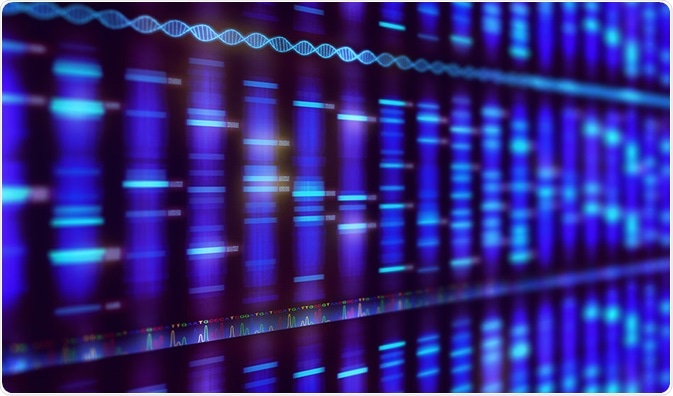
Sanger sequencing and next-generation sequencing compared
Currently, the two most popular methods of DNA sequencing are Sanger sequencing and next generation sequencing (NGS). Whilst NGS has largely overtaken Sanger sequencing, it is still used by researchers today due to its simplicity and ease of use.

Credit: ktsdesign/Shutterstock
Sanger sequencing was developed in the 1970s by Frederick Sanger and was the original DNA sequencing method.
In Sanger sequencing, chain-terminating nucleoside bases are incorporated into the DNA replication reaction. This results in a series of DNA chains truncated at each base pair in the sequence. The sequence is then read by separating these chains on a polyacrylamide gel.
Next generation is a newer method that can be used to sequence much larger pieces of DNA, or even whole genomes. It is based on sequencing during the DNA synthesis reaction. The reaction is carried out on a fixed surface. Each time a base is added, the new sequence information is read. Thousands of reactions can be sequenced simultaneously.
Illumina
The dominant next-generation sequencing platform is Illumina. It was originally developed by David Klenerman at the University of Cambridge, and commercialized by Solexa in 1998. Illumina purchased Solexa in 2007, acquiring the technology.
Illumina’s method has a similar concept to Sanger sequencing. In Sanger sequencing, chain-terminating di-deoxynucleosidetriphosphates (ddNTPs) are incorporated into DNA chains during DNA replication using template DNA and a primer to begin the reaction.
In Illumina sequencing, reversible terminators are attached to regular deoxynucleosidetriphosphates (dNTPs). The terminator blocks extension of the DNA chain.
However, the terminators are reversible, so after readout, the terminator is removed and another base is added to the chain. The cycle is then repeated for the full read length of the fragment.
Detection
In Sanger sequencing, the terminated chains are separated on a polyacrylamide gel. The primers (dNTPs) are labeled with a radioactive isotope, or, more commonly, a fluorescent label. The sequence is then read out all at once. With fluorescence detection, four different fluorescent colors are used to distinguish the different bases.
For Illumina sequencing, detection is carried out using a fluorescent label bonded the dNTP. A single fluorescent dye is used for all bases, and each dNTP is added separately to distinguish them from one another.
DNA sequence yield
The primary practical difference between Sanger sequencing and next generation sequencing is the yield of sequence data.
Illumina’s sequencing machine can produce up to 20 mega bases (Mb) per hour with a read length of 100 bases from both ends of the template. Slab gel Sanger sequencing produces 0.0672 Mb/hr with a read length of 700 bp.
Cost
The relative cost of Sanger sequencing is higher than NGS. Sanger sequencing is estimated at about $500 per 1000 bases, compared to less than $0.50 per 1000 bases for NGS, according to a 2011 study.
When to use Sanger sequencing
Next generation sequencing technology is now preferred for certain jobs. Those include:
- sequencing more than 100 genes simultaneously
- expanding the number of targets to find novel variants
- samples with low input amounts of starting material
- microbial genomes for pathogen subtyping in critical outbreak situations
Sanger sequencing is still a good choice when:
- sequencing single genes
- Sequencing amplicon targets up to 100 base pairs
- sequencing 96 samples or less
- identifying of microbes
- analyzing fragments
- analyzing short tandem repeats (STRs)
Reviewed by Afsaneh Khetrapal Bsc (Hons)
Sources
- Comparison of targeted next-generation sequencing and Sanger sequencing for the detection of PIK3CA mutations in breast cancer
- Canard, Bruno; Sarfati, Robert S. (1994-10-11). "DNA polymerase fluorescent substrates with reversible 3′-tags". Gene. 148 (1): 1–6. DOI:10.1016/0378-1119(94)90226-7
- Sequencing-by-Synthesis: Explaining the Illumina Sequencing Technology
- Cost analysis of standard Sanger sequencing versus next generation sequencing in the ICONIC study
- When do I use Sanger sequencing vs. NGS?
- Applications of next-generation sequencing technologies in functional genomics






















.png)












No hay comentarios:
Publicar un comentario